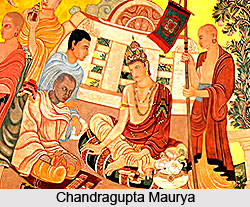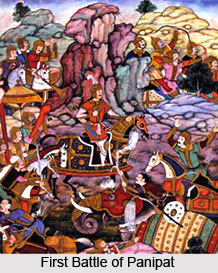 Military organisation in ancient India was maintained by the state. At a later date the organisation also included the commissariat and medical personnel. The Senani-Quarter-Master General looked after the comfort, welfare and health of troops. The Superintendent of Stores supervised the commissariat department also. He arranged for necessity supplies and ensured the preservation of water, food and fodder, clothing, arms and other equipment including transport during operations. Transport animals in use were horses, elephants, camels, oxen and donkeys. They helped in the carrying of the wounded from the field to the rear areas, procuring water for the use of the army and conveying arms and other stores to the front line. Physicians with surgical instruments, medicines, oils for massage and bandages and women with cooked food and beverages, remained behind to provide relief and encouragement to the wounded. Further, there was a corps of physicians in the Mauryan times also.
Military organisation in ancient India was maintained by the state. At a later date the organisation also included the commissariat and medical personnel. The Senani-Quarter-Master General looked after the comfort, welfare and health of troops. The Superintendent of Stores supervised the commissariat department also. He arranged for necessity supplies and ensured the preservation of water, food and fodder, clothing, arms and other equipment including transport during operations. Transport animals in use were horses, elephants, camels, oxen and donkeys. They helped in the carrying of the wounded from the field to the rear areas, procuring water for the use of the army and conveying arms and other stores to the front line. Physicians with surgical instruments, medicines, oils for massage and bandages and women with cooked food and beverages, remained behind to provide relief and encouragement to the wounded. Further, there was a corps of physicians in the Mauryan times also.
According to Kautilya`s Arthashastra, a good army had to be ever ready to obey the commands of its leaders under all circumstances and be able to operate in all types of tracts. It also stated that an efficient army could even exercise the functions of a minister. As mobility was more and more the requirement of warfare with the formations of larger kingdoms, the chariots retreated into the back-ground until they disappeared altogether from the battle-field in the seventh century. In their hey-day, however, they were considered superior to all the other arms. Moreover, in a battle a chariot was an autonomous fighting unit. It contained two drivers, two archers with bows and arrows and two men with shields. Usually, a chariot was drawn by four horses. During the reign of Chandragupta Maurya the chariot was a lighter vehicle and had only three men in it - a driver and two fighting men. It was pulled by two and in some cases four horses. Until recently these chariots could be seen in some of the Rajput states in their full glory on certain ceremonial occasions.
Military Organisation under Mauryan Rule
In military organisation in ancient times, with the shift of emphasis, cavalry and infantry continued to grow in stature until the latter became the queen of the battle-field and the former its gallant cavalier. During the Maurya Empire the cavalry had reached a high standard of efficiency. Under Chandragupta Maurya, the military organisation was really large that included a force of 30,000 cavalry, 20,000 infantry, 8,000 chariots and 6,000 elephants.  The cavalry had the most important function to perform. It included exploitation of the captured territory including positions, camps and forests, holding of strategic positions such as water tanks, fording places, destruction or protection of the commissariat and of reserve troops, superintendence of the discipline of the army during battle, defence of the borders and imparting the initial shock to the enemy. During defence the troops was given the task of holding a given piece of ground to force the enemy to take a desired direction, to attack in the rear and then pursuit. Shock tactics of the cavalry included running against, running round, running beyond, running back, disturbing the enemy`s halt, gathering the troops, curving, circling, clearance of the rear, pursuit of the line from the front, protection of the defeated and retreating army and falling upon the retreating enemy. The smallest unit of the army was a party of ten men under a commander - padika. A Senapati had ten padika under him. There were ten senapatis under a Naik. The Naik of Mauryan times had ten thousand men under him.
The cavalry had the most important function to perform. It included exploitation of the captured territory including positions, camps and forests, holding of strategic positions such as water tanks, fording places, destruction or protection of the commissariat and of reserve troops, superintendence of the discipline of the army during battle, defence of the borders and imparting the initial shock to the enemy. During defence the troops was given the task of holding a given piece of ground to force the enemy to take a desired direction, to attack in the rear and then pursuit. Shock tactics of the cavalry included running against, running round, running beyond, running back, disturbing the enemy`s halt, gathering the troops, curving, circling, clearance of the rear, pursuit of the line from the front, protection of the defeated and retreating army and falling upon the retreating enemy. The smallest unit of the army was a party of ten men under a commander - padika. A Senapati had ten padika under him. There were ten senapatis under a Naik. The Naik of Mauryan times had ten thousand men under him.
Role of Animals in Military Organisation in Ancient Times
Military organisation in ancient times also included a large number of animals. They played a great role. Like for instance, elephants led the attack by providing a solid front. These animals have figured prominently in almost all important battles in the country. During assault they were used to break up the enemy`s ranks and also for smashing fort gates and other obstacles in front of the forts and fortifications. They also helped in crossing impassable and unaffordable rivers by forming a bridge. These animals were again the undoing of the Indian side during the Battle of Hydaspes against Alexander. The elephants again played a vital role in repeating their earlier performance some 1800 years later at the First Battle of Panipat in 1526 and then again in 1556 at the same battlefield.
Moreover, the Nitiprakasika and Sukraniti have also given elaborate and varied details of the various divisions of the army. According to the latter, a sergeant had five or six soldiers under him. The captain or satanika commanded one hundred such soldiers. To help the king in the training and administration of the army two more officers were detailed. They were anusatika responsible for the training and the senani for the administration and general comforts of the men. The lekhaka served as a clerk and maintained all the records. A commander of twenty elephants or horses was known as a naik.




















